Pathological function of Ca2+-sensing receptor in pulmonary arterial hypertension
- PMID: 24770445
- PMCID: PMC5137257
- DOI: 10.1540/jsmr.50.8
Pathological function of Ca2+-sensing receptor in pulmonary arterial hypertension
Abstract
Pulmonary arterial hypertension (PAH) is defined as an intractable disease characterized by a progressive elevation of pulmonary vascular resistance (PVR) and pulmonary arterial pressure (PAP), leading to right heart failure and premature death. The five-year survival rate after diagnosis is approximately 57%. Although extensive research has identified some factors associated with the cause of PAH, the etiology and pathogenesis remain unclear. In addition to Ca(2+) channel blockers (nifedipine, diltiazem), three categories of drug have been developed for the treatment of PAH based on the pathological mechanisms: prostacyclin and its analogues (epoprostenol, treprostinil, iloprost), endothelin receptor antagonists (bosentan, ambrisentan), and phosphodiesterase type 5 inhibitors (sildenafil, tadalafil). However, screening of novel types of drug acting on the signal pathway associated with the pathological mechanism underlying PAH is ongoing. We recently found that the extracellular Ca(2+)-sensing receptor (CaSR), which belongs to family C of the G protein-coupled receptor (GPCR) superfamily, is upregulated in pulmonary arterial smooth muscle cells (PASMCs) from patients with idiopathic PAH (IPAH). The upregulated CaSR is necessary for the enhanced Ca(2+) signaling and the augmented cell proliferation in PASMCs from IPAH patients. Most importantly, blockage of CaSR with an antagonist, NPS2143, prevents the development of pulmonary hypertension and right ventricular hypertrophy in animal models of pulmonary hypertension. The use of calcilytics, antagonists of CaSR, may be a novel therapeutic approach for PAH patients.
Figures





Similar articles
-
Inhibition of Excessive Cell Proliferation by Calcilytics in Idiopathic Pulmonary Arterial Hypertension.PLoS One. 2015 Sep 16;10(9):e0138384. doi: 10.1371/journal.pone.0138384. eCollection 2015. PLoS One. 2015. PMID: 26375676 Free PMC article.
-
[Enhanced Ca2+-sensing receptor function in pulmonary hypertension].Yakugaku Zasshi. 2013;133(12):1351-9. doi: 10.1248/yakushi.13-00228-3. Yakugaku Zasshi. 2013. PMID: 24292183 Review. Japanese.
-
[Molecular Mechanism of Dihydropyridine Ca2+ Channel Blockers in Pulmonary Hypertension].Yakugaku Zasshi. 2016;136(10):1373-1377. doi: 10.1248/yakushi.16-00086. Yakugaku Zasshi. 2016. PMID: 27725386 Review. Japanese.
-
Enhanced Ca(2+)-sensing receptor function in idiopathic pulmonary arterial hypertension.Circ Res. 2012 Aug 3;111(4):469-81. doi: 10.1161/CIRCRESAHA.112.266361. Epub 2012 Jun 22. Circ Res. 2012. PMID: 22730443 Free PMC article.
-
Platelet-derived growth factor up-regulates Ca2+-sensing receptors in idiopathic pulmonary arterial hypertension.FASEB J. 2019 Jun;33(6):7363-7374. doi: 10.1096/fj.201802620R. Epub 2019 Mar 13. FASEB J. 2019. PMID: 30865840
Cited by
-
Effect of miR-23a on anoxia-induced phenotypic transformation of smooth muscle cells of rat pulmonary arteries and regulatory mechanism.Oncol Lett. 2017 Jan;13(1):89-98. doi: 10.3892/ol.2016.5440. Epub 2016 Nov 28. Oncol Lett. 2017. PMID: 28123527 Free PMC article.
-
Inhibition of Excessive Cell Proliferation by Calcilytics in Idiopathic Pulmonary Arterial Hypertension.PLoS One. 2015 Sep 16;10(9):e0138384. doi: 10.1371/journal.pone.0138384. eCollection 2015. PLoS One. 2015. PMID: 26375676 Free PMC article.
-
A Case of Lithium-Associated Hypocalciuric Hypercalcemia.Cureus. 2020 Sep 23;12(9):e10606. doi: 10.7759/cureus.10606. Cureus. 2020. PMID: 32983744 Free PMC article.
-
Role of the calcium-sensing receptor in regulating vascular function.J Cell Commun Signal. 2025 Feb 5;19(1):e70004. doi: 10.1002/ccs3.70004. eCollection 2025 Mar. J Cell Commun Signal. 2025. PMID: 39912052 Free PMC article. Review.
-
Antagonizing amyloid-β/calcium-sensing receptor signaling in human astrocytes and neurons: a key to halt Alzheimer's disease progression?Neural Regen Res. 2015 Feb;10(2):213-8. doi: 10.4103/1673-5374.152373. Neural Regen Res. 2015. PMID: 25883618 Free PMC article. Review.
References
-
- Rich S, Dantzker DR, Ayres SM, Bergofsky EH, Brundage BH, Detre KM, Fishman AP, Goldring RM, Groves BM, Koerner SK, Levy PC, Reid LM, Vreim CE, Williams GW. Primary pulmonary hypertension. A national prospective study. Ann Intern Med. 1987; 107(2): 216–23. doi: 10.7326/0003-4819-107-2-216 - DOI - PubMed
-
- Badesch DB, Raskob GE, Elliott CG, Krichman AM, Farber HW, Frost AE, Barst RJ, Benza RL, Liou TG, Turner M, Giles S, Feldkircher K, Miller DP, McGoon MD. Pulmonary arterial hypertension: baseline characteristics from the REVEAL Registry. Chest. 2010; 137(2): 376–87. doi: 10.1378/chest.09-1140 - DOI - PubMed
-
- Simonneau G, Robbins IM, Beghetti M, Channick RN, Delcroix M, Denton CP, Elliott CG, Gaine SP, Gladwin MT, Jing ZC, Krowka MJ, Langleben D, Nakanishi N, Souza R. Updated clinical classification of pulmonary hypertension. J Am Coll Cardiol. 2009; 54 (1 Suppl): S43–54. doi: 10.1016/j.jacc.2009.04.012 - DOI - PubMed
-
- Yu Y, Fantozzi I, Remillard CV, Landsberg JW, Kunichika N, Platoshyn O, Tigno DD, Thistlethwaite PA, Rubin LJ, Yuan JX. Enhanced expression of transient receptor potential channels in idiopathic pulmonary arterial hypertension. Proc Natl Acad Sci USA. 2004; 101(38): 13861–6. doi: 10.1073/pnas.0405908101 - DOI - PMC - PubMed
Publication types
MeSH terms
Substances
LinkOut - more resources
Full Text Sources
Other Literature Sources
Medical
Research Materials
Miscellaneous

